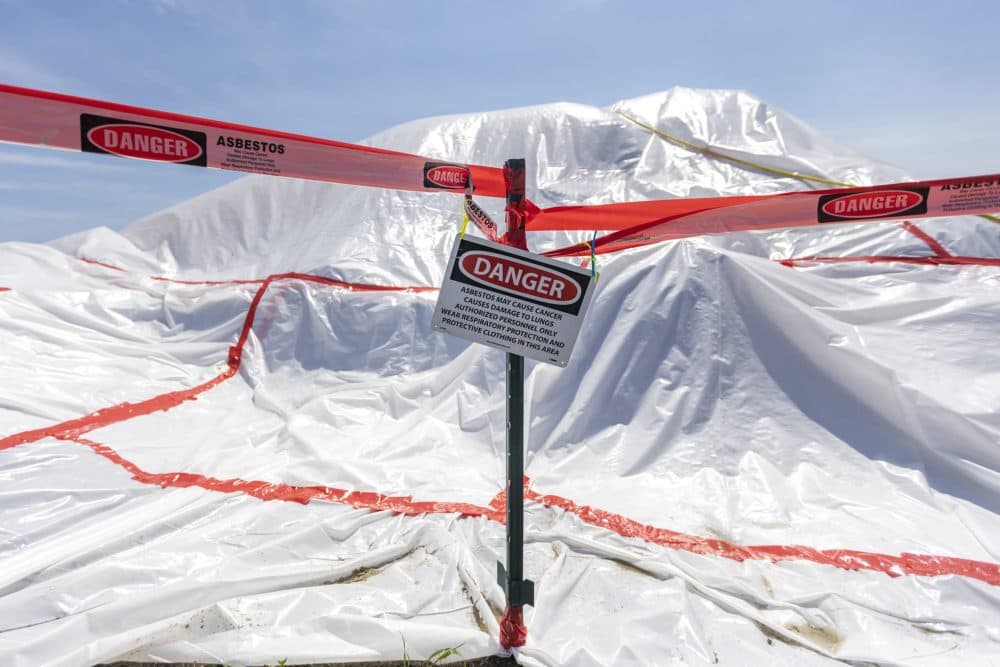Advertisement
Asbestos found in construction debris dumped in Chelsea

At first, Roseann Bongiovanni didn't think too much about the pile of debris she spotted Monday night on Route 1, at the exit ramp to Route 16. She thought it was odd, since there wasn't any construction nearby, but she didn't dwell on it.
The following day, however, she became alarmed.
Bongiovanni, executive director of the Chelsea-based environmental nonprofit GreenRoots, got a call from Chelsea City Council President Roy Avellaneda, asking what she knew about the pile, which had a "Danger: Asbestos" sign by it.
She knew that asbestos was dangerous, and this pile sits very close to the Fitzpatrick public housing complex. But that was it.
She contacted other city officials, who, it turns out, were also trying to figure out where this material came from and whether it posed an immediate threat to residents. Someone from the state eventually confirmed that the contaminated material came from the Belden Bly bridge project, more than two miles away.
“They had to go out of their way to bring it from that location on the Lynn-Saugus line all the way over to Chelsea,” she said. “We were outraged … It’s literally 150 feet away from the closest residences at the Chelsea Housing Authority.”
Though now banned, asbestos was once commonly used in building materials. If asbestos-laden debris is disturbed or broken apart, small fibers can become airborne and inhaled. According to the U.S. Environmental Protection Agency, exposure to asbestos can cause lung cancer or other lung-related health issues.
Chelsea City Manager Thomas G. Abrosino called the situation "appalling" and said he was insulted that the state didn't notify his office about the plan to store the debris so close to where people live.
Chelsea is "one of the most adversely environmentally impacted communities in the commonwealth," he said. "And leaving aside whether it was contaminated, just the fact that you're dumping debris from another community's project is really very disrespectful to the city."
A letter from the Massachusetts Department of Transportation highway administrator, Jonathan Gulliver, to Ambrosino said that the debris is largely soil excavated from the bridge construction site. After a visual inspection found no signs of potentially contaminated building materials, the debris was transported to Chelsea.
Upon further examination, a worker noticed some pipe and building materials in the debris pile. The materials were tested for asbestos and the results came back positive. The state Department of Environmental Protection was notified and helped develop a special disposal plan for the material, according to the letter.
Gulliver wrote that state officials and project contractors “have treated the stockpiled material in accordance with all regulations and at no time was the health and safety of the community at risk.” He added that the pile was covered on May 4 and will start being removed in the next few weeks.
A spokeswoman for the Department of Transportation said the state began moving soil to the location in Chelsea last summer, and that workers notified the Department of Environmental Protection as soon as asbestos was discovered. (She did not say when the asbestos was found, but WBUR obtained an email from an employee of the Department of Environmental Protection stating the agency approved the plan to manage the hazardous materials in March 2022.)
"MassDOT is working closely with the Department of Environmental Protection, the City of Chelsea and other stakeholders to resolve the issue," the spokeswoman said. She added that the agency is working on plans to take the material to an out-of-state disposal site, and expects that work to begin in the next few weeks.
“There are places over near that bridge that they could have temporarily stored [the debris] that would be away from residents,” Bongiovanni said. “Why bring it to Chelsea?”
Bongiovanni said she can’t get a clear answer from state officials about why this area was selected.
“This is just egregiously poor decision making on behalf of the [Department of Transportation] and whatever subcontractors they're using,” she said. “We're just outraged and shocked that they would make yet another mistake and just put a construction debris pile next to low income residents and residents of color.”
This isn't the first time Chelsea residents have been downwind from potentially harmful construction debris. During several nights in May 2020, fine white dust from a different Department of Transportation construction project on the Tobin Bridge blew into Chelsea and coated streets, cars and homes.
All neighborhoods in Chelsea are state-designated environmental justice blocks — the residents who live there are largely non-white, lower income and/or don't have an adult in the household who speaks English fluently.
Chelsea has long been a community forced to bear a disproportionate burden of harmful industries and pollutants. It's home to much of the region's road salt and its residents — who have high rates of asthma, heart disease, lung disease and cancer — breathe the exhaust fumes from thousands of diesel trucks that drive in and out of the city daily.
"This is environmental injustice, and it is unacceptable," Attorney General Maura Healey wrote in a statement to WBUR about the asbestos incident. "We are working with our partner agencies and the Chelsea community — which has unjustly borne environmental harms for years — to help make this right."
A spokeswoman for the Attorney General said that the office is looking into how this debris ended up Chelsea and what can be done to safely remove it as soon as possible.
In his letter, Gulliver apologized for not informing the city about the construction debris and the positive asbestos test.
But Bongiovanni isn’t satisfied. She wants an apology to residents of Chelsea for putting the pile in their neighborhood in the first place.
“They're dumping this pile of cancer-causing agents in our community — that's what they should be sorry for. They should be sorry for that huge mistake they made, not a miscommunication,” she said. “Why do environmental justice communities always have to fight? You know, it shouldn't be that we have to fight for our right to clean air day in and day out.”
This article was originally published on May 05, 2022.
